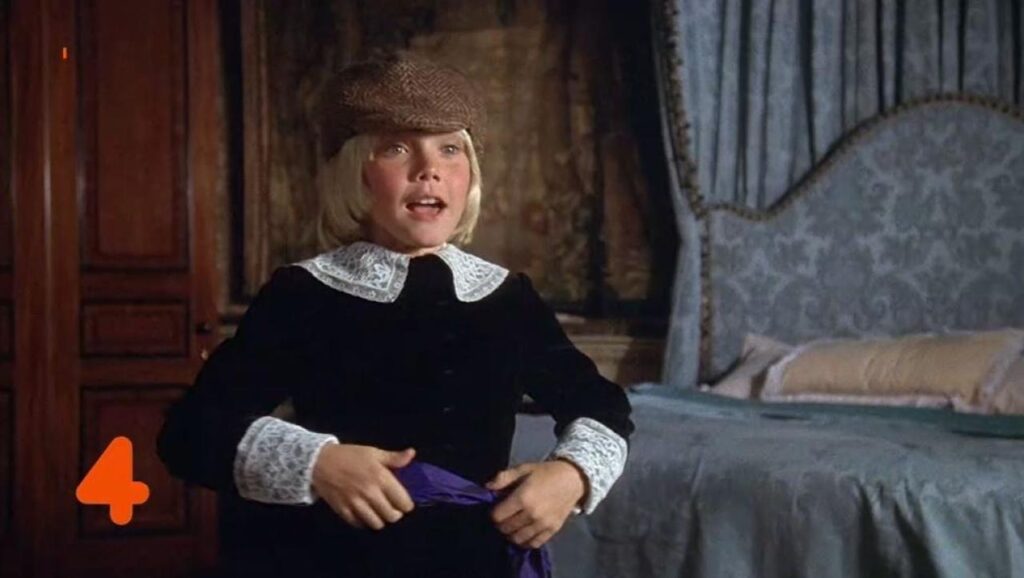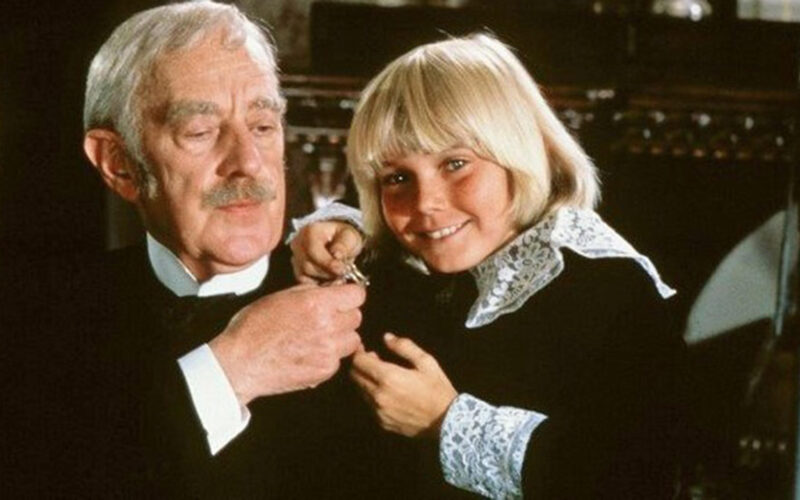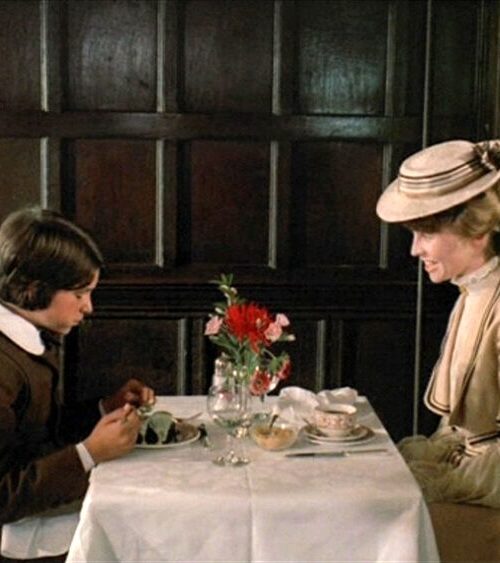“Little Lord Fauntleroy,” a 1980 film directed by Jack Gold starring Rick Schroeder and Alec Guinness, depicts an American child transforming a grumpy British nobleman into a kindly grandfather simply by existing. Lord Dorincourt’s transformation is a stroke of luck for him, but what about the rest of us? Well, we’re stuck with a protagonist so overly sweet he could be mistaken for a bag of sugar.
Cedric, or “Little Lord Fauntleroy,” is practically an angel in socks and knickers. His perfection as a catalyst of good cheer is so pronounced that one almost expects wings and a halo to appear at any moment. Speaking as if he stepped out of a 19th-century novel, there are times when you might want to gag him with a sock just to avoid another “Oh, dear grandfather” or “Yes, sir.”
The film fully embraces Victorian-era nostalgia, a time when children were seemingly miniature adults unaware of what a PlayStation is. As we witness moral lessons steeped in tea and cravats, it becomes clear that Cedric is less a character and more a means to redeem all the adults around him.
So, if you’re looking for a film that makes you feel like you’re trapped in a Christmas card for 102 minutes, “Little Lord Fauntleroy” is for you. Otherwise, you might want to save your socks for more practical uses.

THE PLOT
Ah, the improbable plot of “Little Lord Fauntleroy,” which almost feels like a fairy tale concocted by a cookie factory’s marketing department. Our young protagonist, Cedric, is an ordinary American boy who discovers he’s the heir to a vast fortune and a noble title in England. What’s more realistic than an American kid turning into an English aristocrat, right?
Upon arriving in Britain, Cedric meets his gruff and distant grandfather, Lord Dorincourt, who shows more affection for his Irish setter than most humans. But alas, even the stony heart of this elderly nobleman is breached by the irresistible charm of Little Lord Fauntleroy.
Meanwhile, Cedric captivates virtually everyone he meets, from servants to neighbors, as if he’s under a “charm” spell that makes him irresistible. And lo and behold, in the span of an hour and a half, the old Lord transforms into a philanthropist, donating to orphanages and singing Christmas carols as if struck by some kind of Christmas magic. Or perhaps it’s just the seductive power of Little Lord Fauntleroy and his boundless optimism.
In the end, everything resolves like a Cinderella fairy tale, but with less pumpkin and more tea. Lord Dorincourt becomes a model grandfather, Cedric becomes a lord (little, of course), and they all live happily ever after in the sugar-spun, rainbow world the film has created.
Suspension of disbelief? Of course, let’s leave it at the entrance, please. There’s only room here for warm hearts and enchanted spirits, in a film that makes you wish for a sequel just to see if Little Lord Fauntleroy can solve world hunger with a single sweet glance and a “Please, sir.”

THE ACTOR (Rick Schroeder)
Ah, the actor portraying our unstoppable Little Lord. Brace yourselves, because this boy is the epitome of adorability, making a golden retriever puppy look tough in comparison. With his oh-so-English golden bob and innocent eyes, it’s as if they took every concept of “tender” and “cute” and stuffed them into a jacket and knickerbockers.
The Little Lord’s blonde bob is practically a character in its own right in the film. This impeccably maintained hairstyle always seems ready for a cover photo of a “Living Well English-style” magazine. But don’t be fooled by the pristine appearance; there’s much more beneath that thick blond hair.
With his angelic little hairstyle, the actor still manages to channel an aura of innocence and purity that could make a field of daisies pale in comparison. And while his cherubic features might make him seem more like a store-window mannequin than a real child, the performer makes us forget this detail with his acting.
So, whether it’s a blonde bob or golden curls, the point is this young actor manages to make us sigh in admiration (or perhaps endurance, depending on taste), keeping the magic of the character and the film alive. In a world where perfect children exist only in children’s books, this is a noteworthy feat.
This little acting phenomenon seems born to play roles requiring cosmic innocence and wisdom beyond his years. It’s a performance calculated to maximize the “aww” effect per minute. And he succeeds, oh does he succeed. After all, it’s not everyone who can make believable a character that seems to have swallowed a 19th-century moral lessons book.
But don’t get me wrong: it’s pure talent. Keeping the audience captivated while essentially being a walking embodiment of powdered sugar is no small feat. The boy has charisma, even if that charisma is packaged in a wrapper so sweet it makes you worry about your blood sugar levels.
In short, the actor playing Little Lord Fauntleroy is perfectly cast for a role that could easily slip into the unbearable. And for that, we must congratulate him. Or perhaps just send a thank you note to the casting directors who discovered this human gem. They might have found the only child on Earth capable of saying phrases like “Oh, dear grandfather” without immediately making us want to gag him with a sock. But beware, even sweetness has its limits, and beyond a certain point, that sock starts to look like an increasingly appealing solution.

THE MOM AUDIENCE
Ah, moms and Little Lord Fauntleroy: a pairing as perfect as tea and biscuits. We all know that moms have a soft spot for adorable kids, and our little protagonist is like a guided missile aimed at maternal hearts. The blond bob, the polite speech, the miniature lord attire—every detail is like irresistible bait cast into a lake full of moms ready to bite the hook.
And it’s not just the looks! No, no. It’s the way he can deliver lines like “Oh, dear grandfather” or “Really, sir?” with such genuine tone that it seems like he’s reading a Hallmark greeting card aloud. Moms can’t help but sigh and think, “Oh, if only my Timmy were this respectful and charming!”
Every time Little Lord Fauntleroy smiles or offers advice that seems to come from a wise old sage in miniature, you can almost hear a chorus of moms exclaiming, “What a wonderful child!” It’s as if he was engineered in a secret lab to maximize his adorableness and heart-melting power.
So, moms, beware. Little Lord Fauntleroy is here to conquer your hearts and, who knows, maybe even persuade you to buy that special Blu-ray edition with extras and exclusive content. Because, in the end, who can resist such an exquisitely perfect child?

STRENGTHS
Let’s delve into the strengths of this intoxicating cinematic syrup. First and foremost, there’s the nostalgic charm. “Little Lord Fauntleroy” is like a time travel journey back to an era that, although never really existed as we see it, is familiar and comforting like a checkered wool blanket.
Secondly, there’s the performance of the protagonist, that little phenomenon of adorability. He is the beating heart of the film, a magnet of sympathy so powerful it attracts every human being within a ten-meter radius. Especially, as we’ve already discussed, moms.
Third, the film gracefully handles themes like family, love, and redemption without becoming too heavy or melodramatic. And let’s face it, watching Lord Dorincourt transform from a grumpy old man to a cuddly grandpa has its appeal.
Finally, we shouldn’t underestimate the power of the British setting. Ancient palaces, lush gardens, and plenty of tea all contribute to an atmosphere that is as close to visual comfort as we can get.
So, despite Little Lord Fauntleroy possibly inducing a low-sugar diet desire, the film undoubtedly has its strengths. It’s like a slice of cake you know you shouldn’t eat but makes you feel good while devouring it.

WEAKNESSES
Ah, the weaknesses, the dark side of the moon for “Little Lord Fauntleroy.” Let’s start with the obvious: the protagonist is so saccharine he could easily double as an artificial sweetener. As adorable as he is, his perfectionism borders on the unrealistic, and after a while, it starts to feel more like an archetype than a real human being.
Then there’s the issue of predictability. If you’ve seen at least one redemption story, you can pretty much predict every plot twist. Grumpy old man meets earth angel, old man changes his ways, everyone is happy. It’s like watching a soccer match when you already know the result.
Moreover, while the film might be a hit among moms and grandparents, it might not have the same impact on a younger or more cynical audience. There’s a complete lack of real tension and conflict, which can leave some viewers wondering where the drama is, or God forbid, the action.
And finally, we can’t ignore the sometimes slow pacing. While the setting and costumes are delightful, at times it feels like the film dwells a bit too much on minute details, as if trying to distill every drop of nostalgia from each scene.
So, while “Little Lord Fauntleroy” undoubtedly has its charming moments, it’s also so steeped in sugar and predictability that it risks narrative hyperglycemia. That’s why, as adorable as it is, the film has its flaws that might turn off those looking for a bit more meat on the bone.

POSTER-WORTHY SCENES
Ah, the poster-worthy scenes! “Little Lord Fauntleroy” is a goldmine for those who love iconic images suitable for wall display. Picture the little protagonist in his lordly attire, with that thick blonde hair (not curls, remember!) and a gaze that could melt Antarctica’s ice. This is first-class poster material.
Then there’s the grand Lord Dorincourt, with his imposing presence and a look that says he’s seen it all and is not easily impressed… until he meets his grandson, of course. A scene with both of them, perhaps sharing a tender embrace or a moment of understanding, would perfectly capture the essence of the film.
And let’s not forget the luxurious interiors and exteriors of the manor. A beautiful view of the castle with Little Lord Fauntleroy in the foreground, maybe admiring the view, could be another poster image.
In short, “Little Lord Fauntleroy” offers a variety of visually captivating moments that could easily become the centerpiece of any room. Yes, they’re almost too perfect, but in a film that’s a sort of Victorian fairy tale, perhaps that’s exactly the point.

A SOCK IN THE MOUTH?
Ah, the moments that make you think: “What if we put a sock in his mouth?” Indeed, there are some scenes in “Little Lord Fauntleroy” that make you want to do just that, mainly due to the protagonist and his excessive perfection.
Consider, for example, his lessons in morality and kindness. They’re so laden with virtue that they almost seem lifted from a 19th-century etiquette manual. It’s almost as if Little Lord Fauntleroy is an incarnation of such pure goodness that it makes him almost inhuman, and at times, frankly irritating.
And then there are the dialogues, oh the dialogues! The way Little Lord Fauntleroy speaks might make you think he was raised by a council of angels and Victorian noblewomen. It’s all so formally impeccable that you could almost imagine the screenwriter staring at an old dictionary while writing every line.
Let’s not forget the scenes where everyone, from servants to family members, seems to instantly fall in love with the little protagonist. Yes, he’s adorable, but also a bit unrealistic, almost as if he has some superpower that makes him irresistible.
In short, while the film has its moments of grace and beauty, there are also points where the idealization of the protagonist becomes so excessive it’s almost ridiculous. And in those moments, well, a sock to put in his mouth doesn’t seem like such a bad idea.












